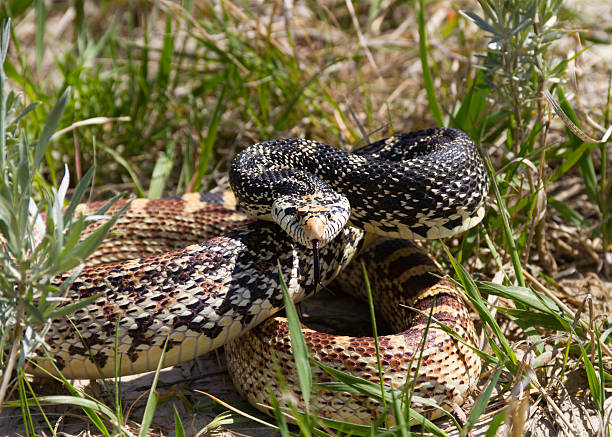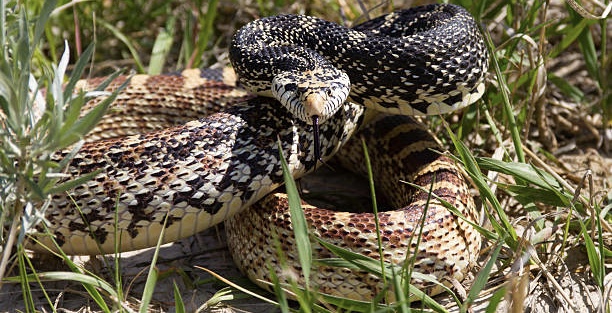ANIMAL: Bullsnake Pituophis sayi Type of Animal: Colubrid Habitat: Plains, grasslands, agricultural fields, watercourses, prairies, mountainous areas, mountainous/lowland conifer forests, semi-desert, desert, pine & oak woodland/forest (open & closed), rodent tunnels, river valleys, sandy areas, brush Location(s): Found in Canada in extreme SE British Columbia, S Alberta, & SW Saskatchewan, much of C US from Idaho/Montana border as far east as W Indiana, & NE Mexico Appearance: Yellow/orangish w/ brown, white, black, or reddish blotching, large blotches on top, 3 sets of spots on sides, black bands on tail, sometimes found in albino and/or white varieties Food/Diet: Mice, rats, gophers, voles, ground & tree squirrels, shrews, rabbits, amphibians, birds (especially ground-nesters-roadrunners sometimes eaten in fights to death), eggs, lizards, smaller snakes, weasels Status in Wild: Stable Conservation: Breeding from zoos & private breeders Lifestyle: Solitary Additional Info: Called: Male Female Young-Snakelet Group-Solitary Weight: 2.2-9.9 lbs Gestation: 2-3 months Life Span: 15-25 years Body Length: Adult-4-6 ft Young-1 ft Tail Length: 1 ft Main predators of adults are raptors, bobcats, coyotes, wolves, foxes, dogs, cats, larger kingsnakes, otters, skunks, bears, raccoons, pigs, & roadrunners. Smaller kingsnakes & short-tailed shrews eat young. Breed in March & April & lay 5-22 eggs from April-June. Kill prey by constriction. They can be active anytime of day. They hibernate in winter. Sexually mature at 3-4 years. To ward off predators, they’ll often make themselves look bigger. They often use rodent burrows/tunnels as refuge. Fun Fact(s): Sometimes kept as pets. Have wide range of temperaments, from docile to defensive. Since they hiss loudly while vibrating their tail, they’re sometimes mistaken for rattlesnakes & even killed. While not venomous, their bite can be painful. Once thought to eat rattlesnakes, which was a reason for them not to be harmed. However, if they do kill them, they would be young ones. Even then, it’s very rare for these snakes to kill rattlesnakes. In fact, they often hibernate together, along w/ garter snakes, hognose snakes, racers, & milk snakes. Highly valued for controlling rodent populations.

